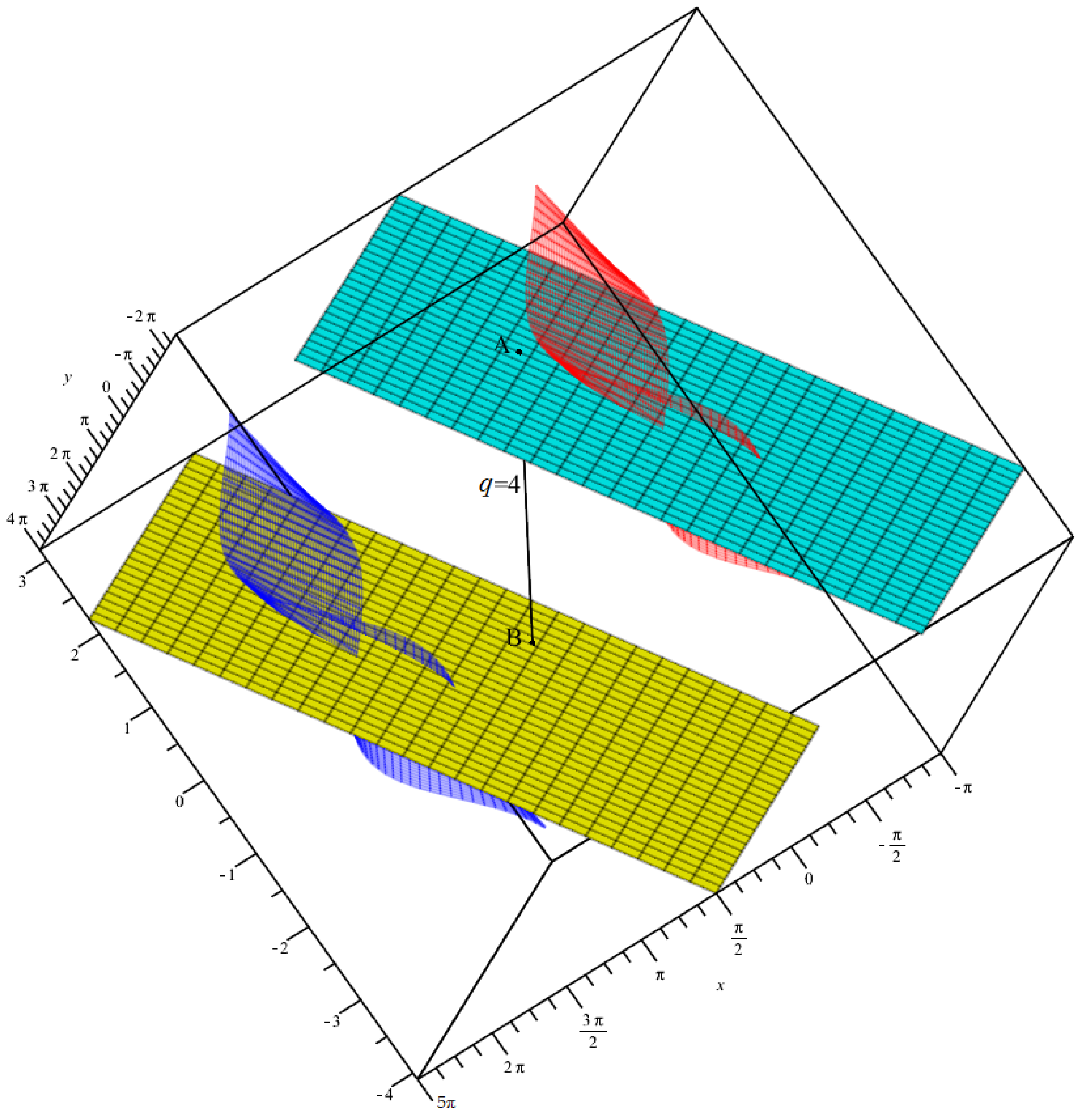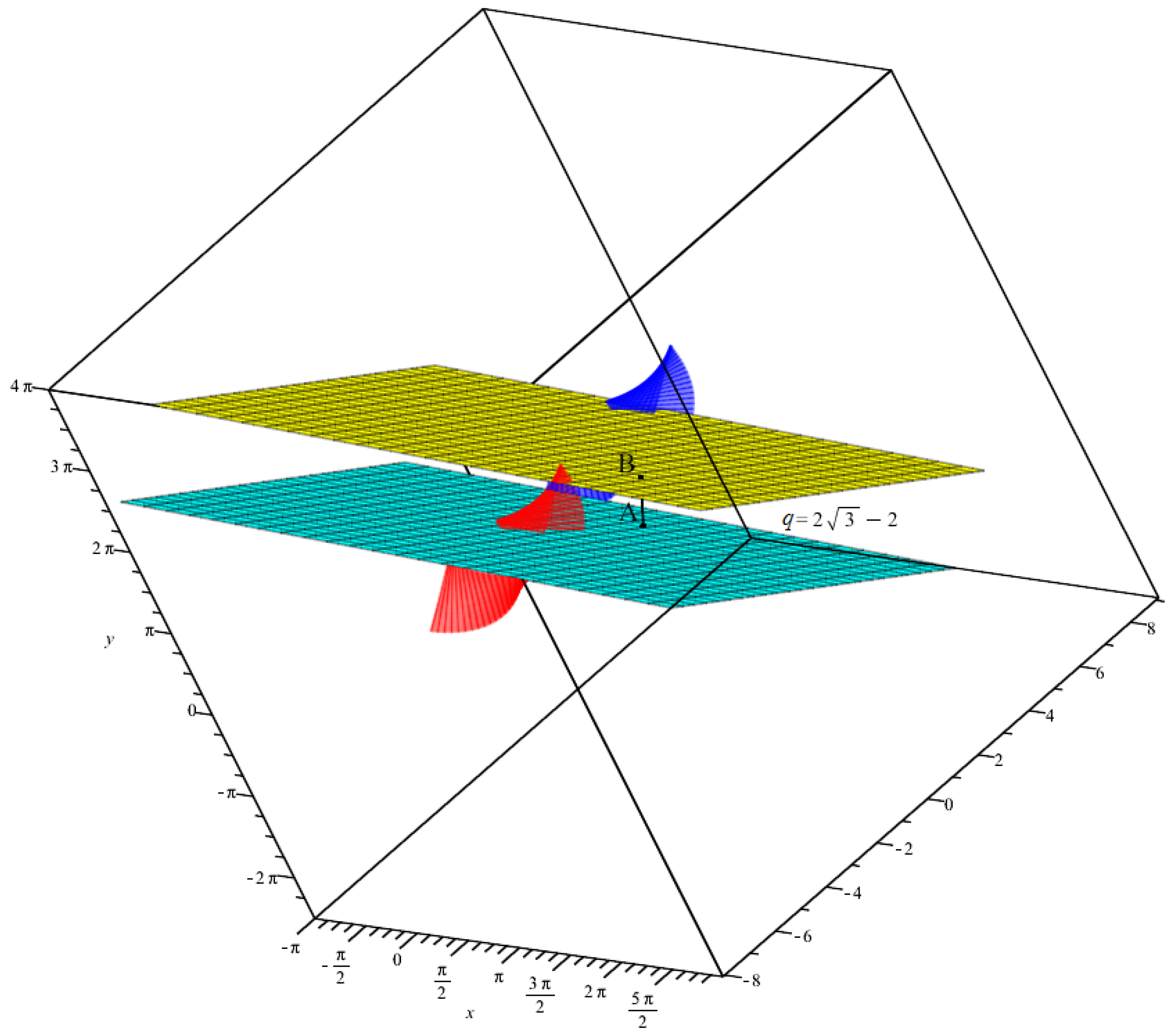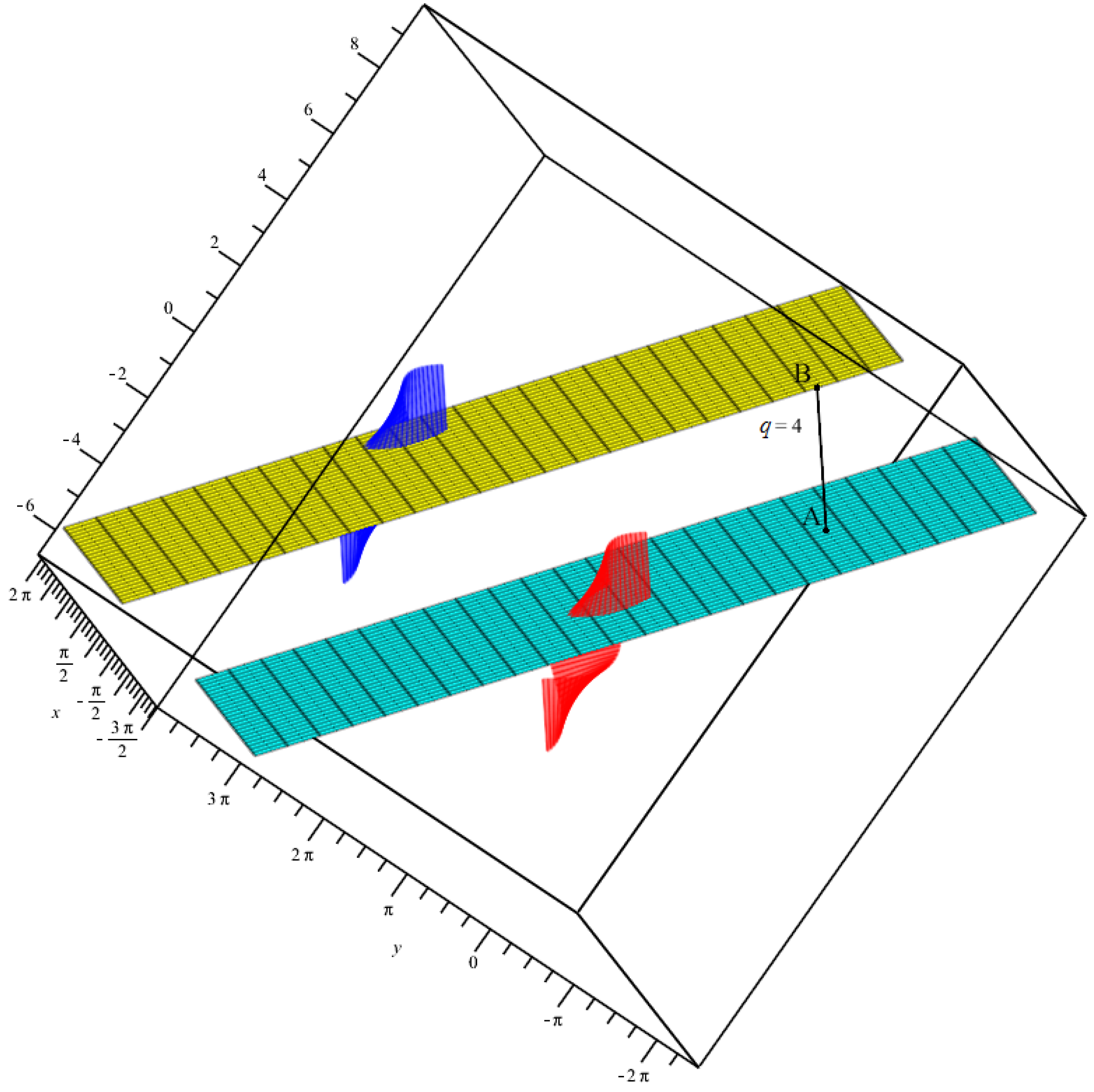The Characterizations of Parallel q-Equidistant Ruled Surfaces
Abstract
1. Introduction and Preliminaries
2. Characteristics of -Equidistant Ruled Surfaces
- the binormal vectors are parallel along the striction curves;
- the distance between two proper points on asymptotic planes is constant,
- For , the striction points, the binormal vectors, the asymptotic planes and the q distance are computed asNow, let us take two proper points from two asymptotic planes as and Since the distance , we can establish a relation for a and b as . For and , we have (See Figure 1).
- For the striction points, the binormal vectors, the asymptotic planes and the q distance are computed asSimilarly, when taken proper points from both asymptotic planes such asandwe may writeIf and , then we can rewrite the last relation asIf this relation is arranged for , then the roots can be computed as and ; that is, andParticularly for we have the corresponding points asSee Figure 2.Note that similar steps can be followed by considering to find different roots and distinct proper points.
- For the striction points, the binormal vectors, the asymptotic planes and the q distance are computed asFor any two points from these asymptotic planeswe have Thus,If again and , then we re-express the last relation as By rearranging the last relation according to , the corresponding roots are found as ; that is, . Note that, in this situation, the asymptotic planes are coincided. See Figure 3.
- For the striction points, the binormal vectors, the asymptotic planes and the q distance are computed asFor such two points on asymptotic planes as the distance Hence,Following the same manner as before, if and , then the above relation takes the formBy arranging this for , the roots are found as and that is, andFor we have the following coordinates for the points A and B asSee Figure 4 If the arrangements are to be done for , another different point pairs can be obtained.
- Lastly, for the striction points, the binormal vectors, the asymptotic planes and the q distance are computed asFor two points from the asymptotic planes,Therefore, If then we have The root to this relation is which corresponds toFor and , we have andSee Figure 5.
3. Conclusions and Discussion
Author Contributions
Funding
Institutional Review Board Statement
Informed Consent Statement
Data Availability Statement
Acknowledgments
Conflicts of Interest
References
- Gray, A.; Abbena, E.; Salamon, S. Modern Differential Geometry of Curves and Surfaces with Mathematica; Chapman and Hall/CRC: Boca Raton, FL, USA, 2017. [Google Scholar]
- do Carmo, M.P. Differential Geometry of Curves and Surfaces; Dover Publications: Mineola, NY, USA, 2016. [Google Scholar]
- Edge, W.L. The Theory of Ruled Surfaces; Cambridge University Press: Cambridge, UK, 2011. [Google Scholar]
- Flöry, S.; Pottmann, H. Ruled Surfaces for Rationalization and Design in Architecture. Available online: http://papers.cumincad.org/cgi-bin/works/paper/acadia10_103 (accessed on 28 July 2022).
- Farin, G. Curves and Surfaces for Computer-Aided Geometric Design: A Practical Guide; Elsevier: Amsterdam, The Netherlands, 2014. [Google Scholar]
- Hunt, K.H. Kinematic Geometry of Mechanisms; Oxford Press: Oxford, UK, 1978. [Google Scholar]
- Valenontis, I. Parallel P-Äquidistante Regelflachen. Manuscripta Math. 1986, 54, 391–404. [Google Scholar] [CrossRef]
- Masal, M.; Kuruoğlu, N. Some Characteristic Properties of the Parallel P-Equidistant Ruled Surfaces in the Euclidean Space. Pure Appl. Math. Sci. India 1999, L1, 35–42. [Google Scholar]
- Masal, M.; Kuruoğlu, N. Some Characteristic Properties of the Shape Operators of Parallel p-Equidistant Ruled Surfaces. Bull. Pure Appl. Sci. 2000, 19E, 361–364. [Google Scholar]
- Masal, M.; Kuruoğlu, N. Some characteristic properties of the Spherical Indicatrix Leading Curves of Parallel p-Equidistant Ruled Surfaces. Bull. Pure Appl. Sci. 2000, 19E, 405–410. [Google Scholar]
- Masal, M.; Kuruoğlu, N. Generalized parallel pi-equidistant ruled surfaces. Acta Comment. Univ. Tartu. Math. 2013, 171, 3–18. [Google Scholar]
- Şenyurt, S. Integral Invariants of Parallel P-Equidistant Ruled Surfaces Which are Generated by Instantaneous Pfaff Vector. Ordu Univ. J. Sci. Tecnol. 2012, 2, 13–22. [Google Scholar]
- Azak, A.Z.; Tosun, M.; Masal, M. Null parallel p-equidistant b scrolls. Bol. Soc. Parana. 2014, 32, 23–34. [Google Scholar]
- Kuruoğlu, N.; Masal, M. Timelike parallel pi-equidistant ruled surfaces by a time-like base curve in the Minkowski 3-space R31. Acta Comment. Univ. Tartu. Math. 2007, 11, 1–13. [Google Scholar]
- Kuruoğlu, N.; Masal, M. Timelike parallel equidistant ruled surfaces by a time-like base curve in the Minkowski 3-space R31. Acta Comment. Univ. Tartu. Math. 2009, 13, 3–9. [Google Scholar]
- Sarıaydın, M.T.; Korpınar, V.; Asil, V. On Parallel p-equidistant Ruled Surfaces by Using Modified Orthogonal Frame with Curvature in E3. Bol. Soc. Paran. Mat. 2022, 2022, 1–7. [Google Scholar]
- Cevahir, C. On Equidistant Parallel Ruled Surfaces Produced by Darboux Vectors in High Dimensional Spaces. Ph.D. Thesis, Institute of Sciences, Ordu University, Ordu, Turkey, 2021. [Google Scholar]
- Gür Mazlum, S.; Şenyurt, S.; Grilli, L. The Dual Expression of Parallel Equidistant Ruled Surfaces in Euclidean 3-Space. Symmetry 2022, 14, 1062. [Google Scholar] [CrossRef]
- As, E.; Şenyurt, S. Some Characteristic Properties of Parallel z-Equidistant Ruled Surfaces. Math. Probl. Eng. 2013, 2013, 587289. [Google Scholar] [CrossRef][Green Version]
- Fenchel, W. On the Differential Geometry of Closed Space Curves. Bull. Am. Math. Soc. 1951, 57, 44–54. [Google Scholar] [CrossRef]
- Yang, Z.C.; Li, Y.; Erdoǧdub, M.; Zhu, Y.S. Evolving evolutoids and pedaloids from viewpoints of envelope and singularity theory in Minkowski plane. J. Geom. Phys. 2022, 104513, 1–23. [Google Scholar] [CrossRef]
- Li, Y.; Ganguly, D.; Dey, S.; Bhattacharyya, A. Conformal η-Ricci solitons within the framework of indefinite Kenmotsu manifolds. AIMS Math. 2022, 7, 5408–5430. [Google Scholar] [CrossRef]
- Li, Y.; Abolarinwa, A.; Azami, S.; Ali, A. Yamabe constant evolution and monotonicity along the conformal Ricci flow. AIMS Math. 2022, 7, 12077–12090. [Google Scholar] [CrossRef]
- Li, Y.; Khatri, M.; Singh, J.P.; Chaubey, S.K. Improved Chen’s Inequalities for Submanifolds of Generalized Sasakian-Space-Forms. Axioms 2022, 11, 324. [Google Scholar] [CrossRef]
- Li, Y.; Uçum, A.; İlarslan, K.; Camcı, Ç. A New Class of Bertrand Curves in Euclidean 4-Space. Symmetry 2022, 14, 1191. [Google Scholar] [CrossRef]
- Li, Y.; Mofarreh, F.; Agrawal, R.P.; Ali, A. Reilly-type inequality for the ϕ-Laplace operator on semislant submanifolds of Sasakian space forms. J. Inequal. Appl. 2022, 1, 1–17. [Google Scholar]
- Li, Y.; Mofarreh, F.; Dey, S.; Roy, S.; Ali, A. General Relativistic Space-Time with η1-Einstein Metrics. Mathematics 2022, 10, 2530. [Google Scholar] [CrossRef]
- Li, Y.; Dey, S.; Pahan, S.; Ali, A. Geometry of conformal η-Ricci solitons and conformal η-Ricci almost solitons on Paracontact geometry. Open Math. 2022, 20, 574–589. [Google Scholar] [CrossRef]
- Li, Y.; Alkhaldi, A.H.; Ali, A.; Laurian-Ioan, P. On the Topology of Warped Product Pointwise Semi-Slant Submanifolds with Positive Curvature. Mathematics 2021, 9, 3156. [Google Scholar] [CrossRef]
- Li, Y.; Haseeb, A.; Ali, M. LP-Kenmotsu manifolds admitting η-Ricci solitons and spacetime. J. Math. 2022, 2022, 6605127. [Google Scholar]
- Todorčević, V. Harmonic Quasiconformal Mappings and Hyperbolic Type Metrics; Springer: Berlin/Heidelberg, Germany, 2019. [Google Scholar]
- Todorčević, V. Subharmonic behavior and quasiconformal mappings. Anal. Math. Phys. 2019, 9, 1211–1225. [Google Scholar] [CrossRef]
- Kojić, V.; Pavlović, M. Subharmonicity of |f|p for quasiregular harmonic functions, with applications. J. Math. Anal. Appl. 2008, 342, 742–746. [Google Scholar] [CrossRef]
- Kojić, V. Quasi-nearly subharmonic functions and conformal mappings. Filomat 2007, 21, 243–249. [Google Scholar] [CrossRef]
- Manojlović, V.; Vuorinen, M. On quasiconformal maps with identity boundary values. Trans. Am. Math. Soc. 2011, 363, 2367–2479. [Google Scholar] [CrossRef]
- Manojlović, V. On bilipschicity of quasiconformal harmonic mappings. Novi Sad J. Math. 2015, 45, 105–109. [Google Scholar] [CrossRef]
- Manojlović, V. Bilipschitz mappings between sectors in planes and quasi-conformality. Funct. Anal. Approx. Comput. 2009, 1, 1–6. [Google Scholar]
- Manojlović, V. Bi-Lipschicity of quasiconformal harmonic mappings in the plane. Filomat 2009, 23, 85–89. [Google Scholar] [CrossRef]
- Manojlović, V. On conformally invariant extremal problems. Appl. Anal. Discret. Math. 2009, 3, 97–119. [Google Scholar] [CrossRef]
- Antić, M.; Moruz, M.; Van, J. H-Umbilical Lagrangian Submanifolds of the Nearly Kähler S3×S3. Mathematics 2020, 8, 1427. [Google Scholar] [CrossRef]
- Antić, M.; Djordje, K. Non-Existence of Real Hypersurfaces with Parallel Structure Jacobi Operator in S6(1). Mathematics 2022, 10, 2271. [Google Scholar] [CrossRef]
- Antić, M. Characterization of Warped Product Lagrangian Submanifolds in Cn. Results Math. 2022, 77, 1–15. [Google Scholar] [CrossRef]
- Antić, M.; Vrancken, L. Conformally flat, minimal, Lagrangian submanifolds in complex space forms. Sci. China Math. 2022, 65, 1641–1660. [Google Scholar] [CrossRef]
- Antić, M.; Hu, Z.; Moruz, M.; Vrancken, L. Surfaces of the nearly Kähler S3×S3 preserved by the almost product structure. Math. Nachr. 2021, 294, 2286–2301. [Google Scholar] [CrossRef]
- Antić, M. A class of four-dimensional CR submanifolds in six dimensional nearly Kähler manifolds. Math. Slovaca 2018, 68, 1129–1140. [Google Scholar] [CrossRef]
- Antić, M. A class of four dimensional CR submanifolds of the sphere S6(1). J. Geom. Phys. 2016, 110, 78–89. [Google Scholar] [CrossRef]
- Ali, A.T. Non-lightlike constant angle ruled surfaces in Minkowski 3-space. J. Geom. Phys. 2020, 157, 103833. [Google Scholar] [CrossRef]
- Ali, A.T. A constant angle ruled surfaces. Int. J. Geom. 2018, 7, 69–80. [Google Scholar]
- Ali, A.T. Non-lightlike ruled surfaces with constant curvatures in Minkowski 3-space. Int. J. Geom. Methods Mod. Phys. 2018, 15, 1850068. [Google Scholar] [CrossRef]
- Ali, A.T.; Hamdoon, F.M. Surfaces foliated by ellipses with constant Gaussian curvature in Euclidean 3-space. Korean J. Math. 2017, 25, 537–554. [Google Scholar]
- Ali, A.T.; Abdel Aziz, H.S.; Sorour, A.H. On some geometric properties of quadric surfaces in Euclidean space. Honam Math. J. 2016, 38, 593–611. [Google Scholar] [CrossRef]
- Ali, A.T.; Abdel Aziz, H.S.; Sorour, A.H. On curvatures and points of the translation surfaces in Euclidean 3-space. J. Egyptian Math. Soc. 2015, 23, 167–172. [Google Scholar] [CrossRef]





Publisher’s Note: MDPI stays neutral with regard to jurisdictional claims in published maps and institutional affiliations. |
© 2022 by the authors. Licensee MDPI, Basel, Switzerland. This article is an open access article distributed under the terms and conditions of the Creative Commons Attribution (CC BY) license (https://creativecommons.org/licenses/by/4.0/).
Share and Cite
Li, Y.; Şenyurt, S.; Özduran, A.; Canlı, D. The Characterizations of Parallel q-Equidistant Ruled Surfaces. Symmetry 2022, 14, 1879. https://doi.org/10.3390/sym14091879
Li Y, Şenyurt S, Özduran A, Canlı D. The Characterizations of Parallel q-Equidistant Ruled Surfaces. Symmetry. 2022; 14(9):1879. https://doi.org/10.3390/sym14091879
Chicago/Turabian StyleLi, Yanlin, Süleyman Şenyurt, Ahmet Özduran, and Davut Canlı. 2022. "The Characterizations of Parallel q-Equidistant Ruled Surfaces" Symmetry 14, no. 9: 1879. https://doi.org/10.3390/sym14091879
APA StyleLi, Y., Şenyurt, S., Özduran, A., & Canlı, D. (2022). The Characterizations of Parallel q-Equidistant Ruled Surfaces. Symmetry, 14(9), 1879. https://doi.org/10.3390/sym14091879






